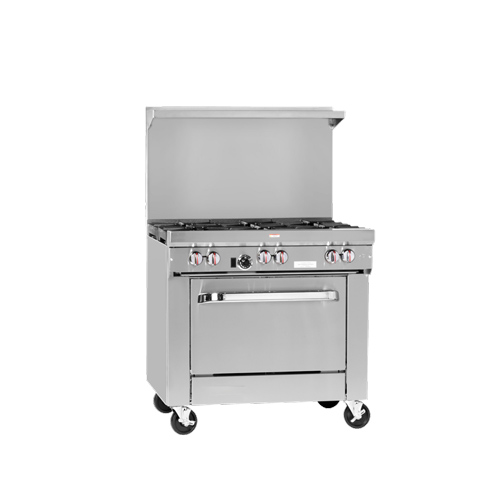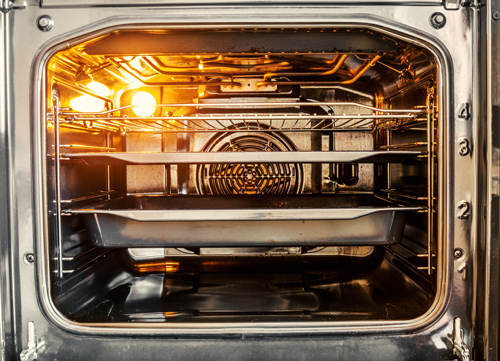Title - What To Consider When Purchasing a Restaurant Range
When it comes to selecting the right commercial range for a restaurant, it is not a cut-and-dry answer. Every restaurant has different needs, including space configurations, menus, power source and so on. Determining the unique requirements of your operation is key anytime you are purchasing a restaurant range.
How Much Space Is There?
The first step in purchasing a commercial range is figuring out how much space is available. Commercial ranges come in a variety of sizes, anywhere from 12 to 72 inches wide. The most common sizes are 36", 48", and 60" wide. Stoves are available in different depths, depending on if it’s a heavy duty or restaurant range. Do not forget to measure your space from front to back, giving your staff enough room to maneuver in front of it while working.
Hood space also needs to be considered. If the hood is 36 inches wide, the width of your restaurant range will have to be smaller, limiting the size of your purchase. Make sure to always check your local code for specific requirements.
What Kind of Range Is Needed?

Determining the type of range that best fits your restaurant is the most important, there are restaurant rages and heavy-duty ranges. Ranges are paramount in almost every kitchen because they are versatile. They can cook, sauté, bake, broil, grill, and more. So, what is the difference?
A lot of this comes down to menu and output; will you mainly be using sauté pans or stock pots, and for how many hours?
Stock pots are large, and therefore need a deeper range to accommodate several pots on the cooktop. If you are doing several hours of stock pot cooking, you will need a heavy-duty range. Another key qualifier is how the oven, or base of the range, is going to be used. If you have heavy oven usage with several door openings, and high temps, like in product finishing, then you may need a heavy-duty range. Heavy-duty ranges are commonly used in high volume kitchens, hotels, country clubs, and other bulk cooking establishments.
Heavy-duty ranges are typically fabricated with a fully welded frame, heavier gauge materials, more stainless-steel components, more BTUs/hour for power, and have modular options for complete customization. The investment in a heavy-duty range will last you several years of output in the highest volume kitchens.
A restaurant range is perfect for a typical restaurant, which handles anywhere between 200 and 1000 meals per day, with minimal stock pot usage per week. The BTU’s and shallow depth are better suited to fit sauté pans, without waste, and overall construction withstands daily usage but not at a high-volume pace. The standard, or conventional, oven is best suited for a couple of pans of food serving a low to moderately busy restaurant at peak hours. If browning is needed, then a convection fan base may be more appropriate for your operation. The fan also allows for a more even bake.
Your menu, staff experience, kitchen layout, and daily volume should determine the type of range needed for your operation.
What Kind of Stovetop Is Needed?
As important as the cooking cavity when purchasing a restaurant range is the type of stovetop that is chosen. Determining what options on the stovetop will function for all menu choices can make the section simpler.
Some choices may include:
The number of burners, which are available up to 12 and determined by the productivity of the commercial kitchen.
The types of surfaces included. Options can include griddle tops, woks, french tops, grills, and other add-ons that can cook different styles.
The heating element may vary by if there is gas or electricity available. But there are also induction surfaces available that are more energy efficient.
Convection vs. Standard Oven

While they might look very similar, the difference between convection and standard ovens can be seen once you open the door.
With a fan inside of the oven, in addition to the heating elements, a convection oven circulates hot air throughout the cavity. This helps meals cook more evenly, no matter where it’s placed in the oven cavity. Typically, food cooks quicker in a convection oven and eliminates the need for regular rotation when baking, allowing your staff to focus on other tasks.
A standard oven usually has a heating element at the bottom of the oven and another, for the broiler, at the top of the oven. Food that is placed closest to the heating element will cook faster than items that are placed in-between. Most conventional recipes are created for a standard oven and more people are familiar with how to use one. This means less training for new staff coming into your kitchen.
ACityDiscount proudly partners with the best restaurant equipment brands available today, and we are proud to carry the industry-leading lines.
To speak to a product specialist in the restaurant supply industry who can discuss which restaurant range is best for you, call 404-752-6715.


